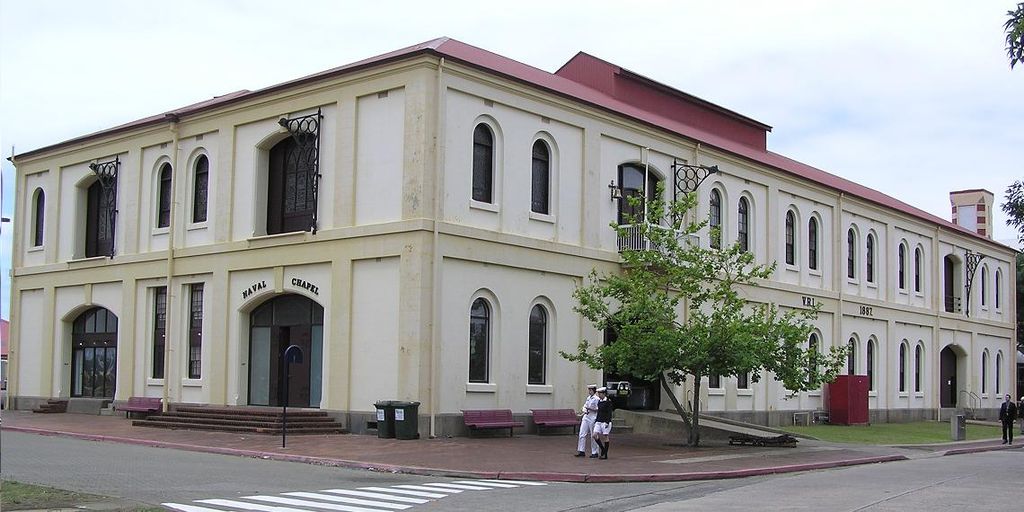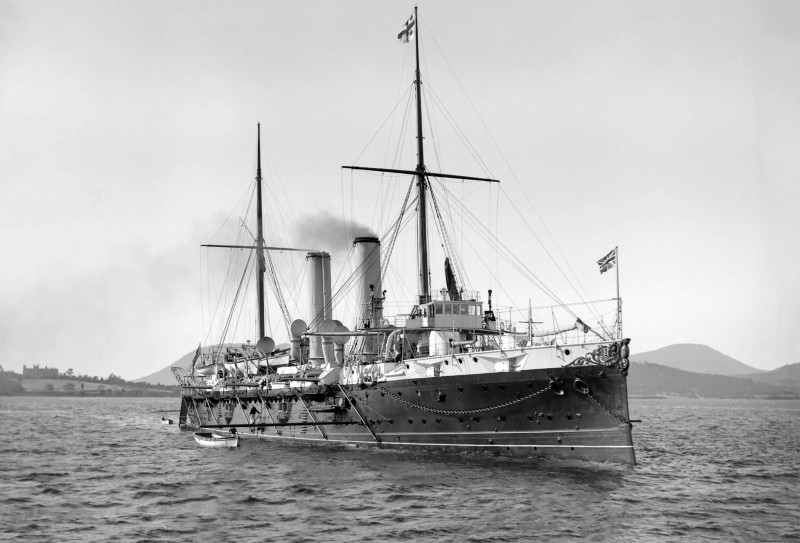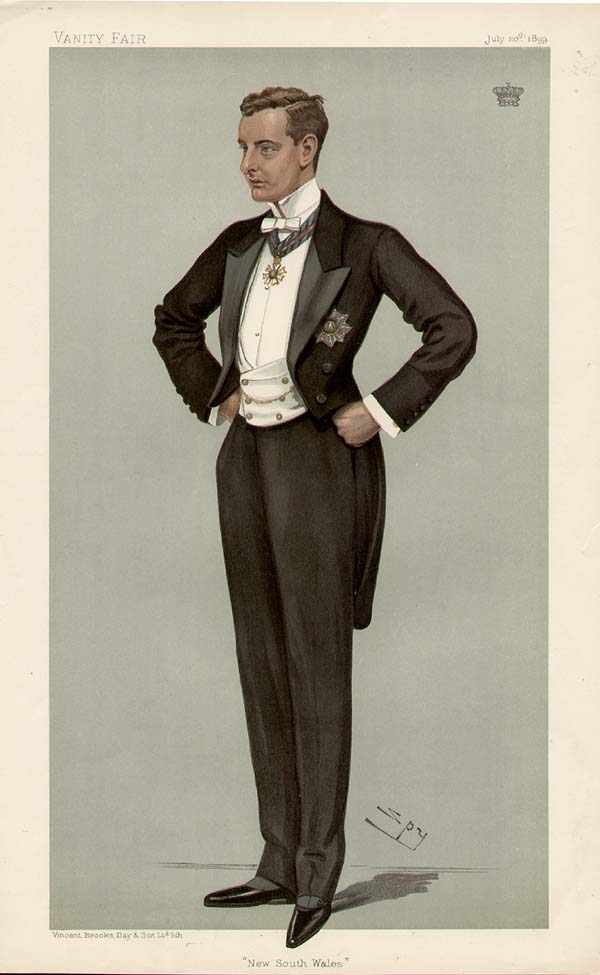- Author
- A.N. Other
- Subjects
- History - pre-Federation
- Tags
-
- RAN Ships
- None noted.
- Publication
- December 2021 edition of the Naval Historical Review (all rights reserved)
Colin Randall, one of our venerable archivists, discovered some newspaper cuttings from well over a century past which perhaps reminds us of how things were done when a celebration was needed.
In setting the scene we should recall that the Australia Station was formed in 1858 when Garden Island became a base for the Royal Naval Squadron allocated to protect our shores. However significant work did not commence on building a depot for many years and it was not until 1888 that the Marine Barracks was built with the lower floor allocated to a detachment of the Royal Marine Light Infantry, the upper floor becoming a hospital and the middle floor temporary accommodation for crews of visiting ships. At the rear of the Barracks was a single storey kitchen, linked to the Barracks by a covered walkway. The Rigging Shed and Sail Loft were completed in 1889 and a large four storey Naval Stores in 1893. With the advent of these buildings lighting was required, and as gas was a fire hazard, a powerhouse was built, delivering a direct current electrical system.
The Sail Loft was completed at a time when steam became the motive power of naval ships; as a result it was oversized and in 1902 it was partially converted to accommodate a Naval Chapel.
With this marvellous new accommodation available, why not show it off by throwing a party, which became the famous Naval Ball of 1899.

Newspaper Reports
Only a few days, earlier on 9 October 1899, the first contingent of troops (NSW Lancers) had departed for the Boer War so comparisons were made between this event and the famous Duchess of Richmond Ball held at Brussels on the eve of the Battle of Waterloo.
The Sydney Morning Herald of Friday 13 October 1899 reported under the banner NAVAL BALL AT GARDEN ISLAND – A BRILLIANT FUNCTION WITH SOME UNIQUE DECORATIONS. With minor editing the following information comes from newspapers and a slightly later report in The Bulletin.
‘A Ball was given last night at Garden Island by his Excellency the Admiral and the officers of the Royal Naval Squadron, which proved a brilliant and successful function. The hosts included Rear Admiral Hugo Pearson, Commander-in-Chief of the Australian Squadron and officers of Her Majesty’s Ships Royal Arthur, Wallaroo, Katoomba, Tauranga and Porpoise. Those in HMS Mohawk also assisted but were not present. Notable guests included Captain Dunbar of the Imperial German Naval Ship Möwe so she must have been in port. Over a thousand guests were entertained and every possible arrangement was made for their enjoyment and comfort by the officers appointed to carry out the details. Boats ran at intervals from Man-o’-War Steps, conveying the guests to Garden Island, which was brilliantly illuminated, and on the way the steamers passed the flagship Royal Arthur, which was a blaze of gleaming and scintillating lights from stem to stern, whilst the flag at the mast head was picked out by multi-coloured arc lamps.

On landing the guests were conducted to three reception rooms over a space comfortably covered in canvas and sailcloth, and to windward a canvas wall had been erected so that the rooms were thus reached without discomfort. The two largest stores had been cleared of their contents, and were tastefully decorated with flags, bunting, naval and military trophies, etc.
The lower storey (of the Rigging Shed) was requisitioned as a supper room and the upper one (the Sail Loft) is the ballroom. A dais, tastefully decorated and furnished, was provided for the vice-regal party. Pyramids of ice, some ten feet in height, were placed at intervals along the centre of the ballroom, enhancing the brilliancy of the scene and the atmosphere. Between these were mounted gigantic torpedoes, which gave no indication of their destructive forces that might be expended, unless it was from the gleaming and glittering steel and brass fittings, burnished as only a British sailor can. The corners of the ballroom were also beautified with varicoloured pyramids of ice flanked with flowers, pot plants and ferns, producing effects which evoked much admiration. The result was that when the guests were assembled and the dances in progress a scene of the utmost beauty and brilliance was presented, with the delicately tinted and soft hues of the dresses forming a pleasing contrast with the gold-laced and brilliant uniforms of the naval and military officers.

Access was gained to the supper room from the ballroom by a carpeted gangway which obviated any necessity for the guests coming into contact with the cold night air or suffering inconvenience from climbing or descending stairs. In the supper-room a large number of separate tables was arranged, each of which was decorated and laid with much skill, lighting arrangements, which were electric throughout, being perfect. Two large chandeliers revolved above the centre table which was provided for His Excellency Lord Beauchamp and the vice regal party.
Those desiring to escape from the pleasures of the ballroom were not forgotten with a large open space in front of the building covered in canvas and sailcloth and furnished with chairs and inviting looking lounges. The band of the Royal Arthur furnished the dance music and also rendered selections during progress of supper. The catering arrangements were carried out by Mr E.D. Tollemache of the Holborn Café, and were thoroughly satisfactory.
Evidence of the care and forethought of the committee was shown from the fact that a fire engine had been placed in close proximity, but happily was not required.
His Excellency the Governor (aged only 27, a very youthful looking vice regal representative) arrived about half past nine and upon landing was received by Flag Captain Dicken and other officers and a guard of honour formed by the marines. The Governor was attended by Captain Wilfred Smith, Major the Hon. R. Lindsay, and Mr Victor Corkran – and not a lady in sight. His Excellency the Admiral received Lord Beauchamp at the ballroom. Soon after the arrival of the vice regal party a formal set of lines was arranged. His Excellency the Governor danced with Mrs Pearson, the Admiral with Mrs See, the Premier with Mrs B. R. Wise, etc.’
There were many pages devoted to naming all the guests and the beautiful attire of the ladies, ‘many of whom wore ribbons of red, white and blue and some adorned with the name ‘Royal Arthur’. The Naval Ball of 1899 was a memorable occasion which will be the talk of the town for years to come’.
Some later observations
At this time the ships of the squadron were generally moored off the island which was little more than a stores and coaling depot. Only minor repair work was undertaken with refits conducted at Cockatoo Island Dockyard.
The large number of guests would have been in their finery for many hours in getting to and from their homes to Man-o’-War Steps, the boat trips to and from the island, supper and dancing. An essential part of the exercise was the need for refreshments and the bathrooms. These were available in the Barrack Building but the centre of activity was the ballroom in the adjacent Sail Loft. To make a seamless access between the two buildings without needing to descend to ground level, a temporary covered suspension bridge was constructed with a slight incline allowing for the height differences between the levels of the respective buildings. The temporary suspension bridge would have been an interesting engineering exercise at about 72 feet (22 m) in length and decorated with seating as well. The Bulletin mentions it was a gusty night and the impromptu bridge leading from the Ballroom trembled and squeaked as the thousand guests passed over it.
There is much mention of the abundance of electric light which was a novelty at this time and generally not available in the average home and only in a few inner city streets.
While outsourcing is now an accepted part of our lives it was unusual in Victorian times. However, it is noted that a civilian caterer was used for this important function.
Perhaps as a tip on recycling to the modern generation there is a note in one newspaper of two new brides wearing their wedding dresses to the Ball!
In summary the impressive heritage buildings that helped form the original naval depot at Garden Island still remain, but in these days, could they again temporarily become the home of music and gaiety as was the case in the Naval Ball of 1899.




